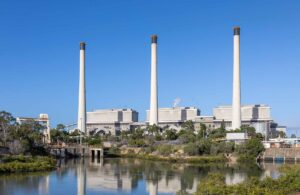Modelling commissioned by the Morrison government shows that failures to adequately respond to the growing climate crisis could see Australia lumped with spiralling costs to service its trillion dollar public debt as global markets punish borrowers for failing to cut emissions.
The predicted impacts on Australia’s public finances due to climate change policies were buried away in policy modelling commissioned by the federal government, but could play a major role in an election campaign set to be fought on economic management.
But the government modelling shows the interest rates paid by Australia for its trillion dollar debt could double, or more, if global investors attach a significant risk premium to the cost of debt for its failure to deal adequately with climate issues.
The CEO of the Climate Bonds Initiative, Sean Kidney, highlighted the modelling in a post on LinkedIn.
“This may be the first such analysis published by a major government on the climate risk to its sovereign debt,” he wrote. “They suggested that cost of their sovereign debt could rise by 100-300bps without clear strategies to reach net-zero.”
According to federal budget documents, Australia currently pays a “weighted average cost of borrowing of around 2.2 per cent” on its sovereign debt, leading to an interest cost of around $19 billion a year. An increase of 300 basis points would potentially add another $24 billion to those annual costs.
The details are included in a report produced by the Department of Industry, Science, Energy and Resources which cites analysis prepared by consultancy McKinsey, as well as the federal treasury.
It suggests Australia can expect to pay much higher interest rates on its trillion dollar debt if it fails to cut greenhouse gas emissions in line with the goals of the Paris Agreement.
The report says the risk premium on government borrowing could be anywhere between 1 and 3 per cent on top of market interest rates.
“It is possible that our cost of capital will rise further than our central estimate of 100 basis points under the ‘adverse global reaction’ scenario, given the strict assumption that Australia is the only developed country not to adopt a net zero target.” the report says.
“Treasury considers that 300 basis points provides a feasible upper bound for these increases. While extreme, this indicates the possible cost impacts of well-coordinated, targeted and enforced global action to restrict access to international capital markets.”
“Such an approach is considered less likely, but is feasible under DISER’s scenario, given the assumptions of coordinated, concerted global emission reduction action.”
“Treasury notes increases in the global cost of action would likely push up Australia’s capital costs further,” the report adds.
This is significant because the federal budget shows Australia’s public debt is approaching $1.2 trillion within the next few years – following a surge in debt levels under the Morrison government has it responded to the Covid-19 pandemic.
The prospect of higher interest rates charged on that debt could cost taxpayers tens of billions each year in higher interest payments.
The report shows the government conceding the fact that global peers, and global finance markets, can be expected to punish economies that fail to adequately respond to climate change.
Australia already faces the genuine threat of carbon border adjustment taxes being imposed on emissions-intensive Australian exports, such as coal, gas, steel and aluminium, by countries that have implemented their own forms of carbon pricing.
The concessions contained within the Morrison government’s climate policy modelling flag the potential for Australia’s rising debt bill could become a massive burden for future governments and the Australian taxpayer, particularly as the unprecedented levels of debt accrued during the Covid-19 pandemic become due to be refinanced over the next few decades.
This could have flow-on impacts for investment within the Australian economy.
“The implementation of the capital risk premium raises the effective cost of capital in Australia,” the report says.
“This results in investment being 2.7% lower on average to 2050, peaking at a 17% reduction a few years after 2030. This flows through to reduce the value of economic activity (GDP) and national income (GNP), with the impact peaking at 0.9% and then declining to about 0.5% by 2050.”
The ‘long term emissions reduction plan’ published by the Morrison government last year detailed that the government expected to cut Australian emissions by 85 per cent by 2050, despite modelling showing the added economic benefits of aiming for deeper cuts.







